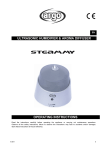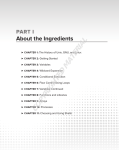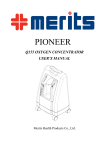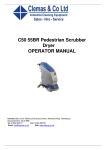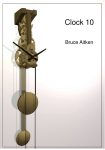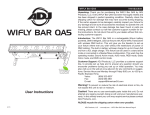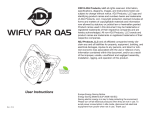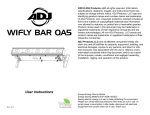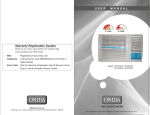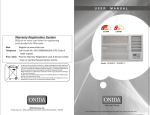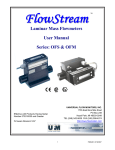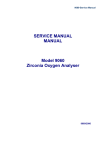Download Q155 Service Manual
Transcript
- Q155 Service Manual Table of Contents 1. Introduction 1-1 1.1. Intended Use............................................................................................... 1-1 1.2. How to Use Service Manual ....................................................................... 1-1 1.3. Safety Rules ............................................................................................... 1-2 1.3.1. Warning .............................................................................................. 1-2 1.3.2. Precaution........................................................................................... 1-2 1.4. Warranty..................................................................................................... 1-3 1.5. Specifications ............................................................................................. 1-4 2. Patient Instructions 2-1 2.1. Unpacking .................................................................................................. 2-1 2.2. Check ......................................................................................................... 2-1 2.3. Routine Maintenance by the patient ............................................................ 2-2 2.3.1. General Caring.................................................................................... 2-2 2.3.2. Cleaning Cabinet Air Intake Filter....................................................... 2-2 2.3.3. Humidifier .......................................................................................... 2-1 3. Operation 3-1 3.1. Description of Operation............................................................................. 3-1 3.2. Exterior Parts.............................................................................................. 3-2 3.3. Handling..................................................................................................... 3-3 3.3.1. Select a location.................................................................................. 3-3 3.3.2. Plug in power cord.............................................................................. 3-3 3.3.3. Connect humidifier (if prescribed by your physician) .......................... 3-4 3.3.4. Start up ............................................................................................... 3-5 3.3.5. Adjust flow rate .................................................................................. 3-5 3.3.6. Oxygen purity indicator ...................................................................... 3-5 3.3.7. Start oxygen therapy ........................................................................... 3-5 3.4. Alarm System............................................................................................. 3-5 3.4.1. Power Failure Alarm Test.................................................................... 3-6 3.4.2. Low Pressure Alarm Test .................................................................... 3-6 3.4.3. High Pressure Alarm Test.................................................................... 3-6 3.4.4. Overheating Alarm Test ...................................................................... 3-7 4. Service 4-1 4.1. Components................................................................................................ 4-1 4.2. Cabinet Removal ........................................................................................ 4-1 4.2.1. Removing the cabinet to access the air compressor ............................. 4-1 4.2.2. Caster Replacement ............................................................................ 4-1 4.3. Unit Block Replacement ............................................................................. 4-2 -i- Q155 Service Manual 4.3.1. Solenoid Valve Assembly Replacement ............................................... 4-2 4.3.2. Solenoid Coil Replacement ................................................................. 4-1 4.3.3. Sieve Bed Replacement....................................................................... 4-2 4.4. Compressor ................................................................................................ 4-3 4.4.1. Compressor Maintenance .................................................................... 4-3 4.4.2. Compressor Assembly Replacement.................................................... 4-3 4.4.3. Compressor Relief Valve Test and Replacement .................................. 4-4 4.4.4. Capacitor Replacement ....................................................................... 4-5 4.5. Axial Fan Replacement............................................................................... 4-6 4.6. Circuit Board Replacement ......................................................................... 4-7 4.6.1. Circuit Board Removal ....................................................................... 4-7 4.6.2. Circuit Board Installation .................................................................... 4-8 4.6.3. Oxygen Sensor Circuit Board Removal............................................... 4-8 4.6.4. Oxygen Sensor Circuit Board Installation ........................................... 4-9 4.7. Product Regulator Setting and Replacement................................................ 4-9 4.8. Circuit Breaker Replacement .....................................................................4-10 4.8.1. Circuit Breaker Removal....................................................................4-10 4.8.2. Circuit Breaker Installation ................................................................4-11 4.9. ON/OFF Power Switch Replacement .........................................................4-11 4.9.1. ON/OFF Power Switch Removal .......................................................4-11 4.9.2. ON/OFF Power Switch Installation....................................................4-12 4.10. Oxygen Monitor LED Replacement ...................................................4-12 4.11.Hour Meter Replacement ...........................................................................4-12 4.12. Flow meter Replacement....................................................................4-13 4.12.1. Flow meter Removal..........................................................................4-13 4.12.2. Flow meter Installation ......................................................................4-14 4.13. Buzzer Replacement ..........................................................................4-14 4.14. Operating Pressure Test......................................................................4-15 4.15. High Operating Pressure ....................................................................4-15 4.16. Low Operating Pressure .....................................................................4-15 4.17. Leak Test Procedure...........................................................................4-16 5. Maintenance 5.1. 5.2. 5.3. 5.4. 5-1 Routine Maintenance .................................................................................. 5-1 Cabinet Air Inlet Filter ................................................................................ 5-1 Air Intake Fine Particle Filter...................................................................... 5-1 Bacteria Filter Replacement ........................................................................ 5-2 6. Troubleshooting 6-1 7. Spare Parts 7-1 8. Tool Kit 8-1 Appendix A: Exploded Drawings ......................................................................A-1 ii Q155 Service Manual List of Illustrations Figure 2-1 Unpacking............................................................................................. 2-1 Figure 2-2 Position of Cabinet Filter ...................................................................... 2-3 Figure 2-3 Clean Cabinet Filter .............................................................................. 2-1 Figure 3-1 Process Schematic................................................................................. 3-1 Figure 3-2 Cabinet ................................................................................................. 3-3 Figure 3-3 Power Cord........................................................................................... 3-3 Figure 3-4 Filling the humidifier ............................................................................ 3-4 Figure 3-5 Attaching the humidifier to oxygen outlet.............................................. 3-4 Figure 3-6 Adjusting the flowrate ........................................................................... 3-5 Figure 3-7 Compressor power connector ................................................................ 3-6 Figure 3-8 Intake solenoid coil and terminal........................................................... 3-7 Figure 3-9 Temperature sensor ............................................................................... 3-7 Figure 4-1 Cabinet fixed screws ............................................................................. 4-1 Figure 4-2 Caster replacement ................................................................................ 4-1 Figure 4-3 waste outlet/air inlet/oxygen outlet ........................................................ 4-2 Figure 4-4 Remove solenoid valve ......................................................................... 4-1 Figure 4-5 Remove solenoid coil ............................................................................ 4-1 Figure 4-6 the mounting band of sieve bed ............................................................. 4-2 Figure 4-7 The suction and feed tubes of compressor ............................................. 4-4 Figure 4-8 The power lead of compressor............................................................... 4-4 Figure 4-9 Loose relief valve.................................................................................. 4-5 Figure 4-10 The capacitor of compressor................................................................ 4-5 Figure 4-11 Intake axial fan.................................................................................... 4-6 Figure 4-12 Exhaust axial fan................................................................................. 4-6 Figure 4-13 Circuit board ....................................................................................... 4-8 Figure 4-14 Oxygen sensor board........................................................................... 4-9 Figure 4-15 Output pressure detect ........................................................................4-10 Figure 4-16 Pressure regulator...............................................................................4-10 Figure 4-17 Leads of Circuit breaker and ON/OFF switch.....................................4-11 Figure 4-18 Unscrew circuit breaker......................................................................4-11 Figure 4-19 Remove ON/OFF switch ....................................................................4-12 Figure 4-20 Oxygen monitor LED connector.........................................................4-12 Figure 4-21 Press down tabs of hour meter............................................................4-13 Figure 4-22 Remove hour meter ............................................................................4-13 Figure 4-23 Uscrew flowmeter nuts.......................................................................4-14 Figure 4-24 Buzzer................................................................................................4-14 Figure 4-25 Detect operating pressure ...................................................................4-15 Figure 5-1 Cabinet air inlet filter ............................................................................ 5-1 Figure 5-2 Air intake fine particle filter .................................................................. 5-2 Figure 5-3 Bacteria filter ........................................................................................ 5-2 Figure 8-1 Tool Kit of Service ................................................................................ 8-1 - iii - Q155 Service Manual Figure A-1 Exploded Drawing of Base Assembly...................................................A-2 Figure A-2 Exploded Drawings of Housing Assembly............................................A-3 Figure A-3 Exploded Drawing of Sieve Bed & Valve Assembly .............................A-4 Figure A-4 Exploded Drawings of Solenoid Valve Assembly..................................A-5 Figure A-5 Exploded Drawing of Sieve Bed Assembly...........................................A-6 Figure A-6 Exploded Drawing of Central Frame Assembly ....................................A-7 Figure A-7 Exploded Drawing of Muffler Assembly...............................................A-8 Figure A-8 Exploded Drawing of Air Compressor Assembly..................................A-9 Figure A-9 Exploded Drawing of Central Frame Assembly ..................................A-10 Figure A-10 Exploded Drawing of Harness Assembly .......................................... A-11 Figure A-11 Exploded Drawing of Accessories.....................................................A-12 iv Q155 Service Manual List of Tables Table 1-1 List of specified warranty period components ......................................... 1-3 Table 1-2 List of consumable.................................................................................. 1-3 Table 1-3 Specification of Oxygen Concentrator .................................................... 1-4 Table 3-1 LED Indicator vs. Oxygen Purity............................................................ 3-5 Table 3-2 The Symptom of Alarm .......................................................................... 3-5 Table 6-1 Troubleshooting...................................................................................... 6-2 Table 7-1 Spare Parts.............................................................................................. 7-1 Table 8-1 Tool Kit .................................................................................................. 8-1 - ii - Q155 Service Manual 1. Introduction The Merits oxygen concentrators are as a solution to deliver a clean, portable and continuous oxygen supply for homecare usage. Merits introduces proudly the Q155 Oxygen Concentrator. These concentrators were built with quality workmanship and designed to be highly reliable systems while maintaining cost effective operation. Since Merits is ISO 13485 and FDA QSR system approved, we have pledged to build only products designed for unmatched reliability and endurance. Subsequently, we are confident that our systems will deliver the necessary consistent concentrated oxygen and flow rate as ordered by your attending physician. Smart monitoring and security control systems allow for constant awareness of possible failures and or malfunctions. The advanced technology utilized by Merits ensures that the patient will always be alerted with audio and visual alarm systems. 1.1. Intended Use The Merits Oxygen Concentrator is intended to be used to supply supplemental oxygen to patients in their home. The devices are not intended for life support nor do they provide any patient monitoring capabilities. Caution Federal Law restricts this device to sale by or on the order of a physician. Caution Do not adjust your prescribed level of oxygen flow without consulting your physician. 1.2. How to Use Service Manual This manual provides instruction for service engineer only to service the Merits Q155 Oxygen Concentrator. This manual includes whole sections in the following: n Introduction n Patient Instructions n Operation n Service n Maintenance n Troubleshooting All section titles, subject subtitles and illustration are listed in the Table of Contents. Note This manual specifically instruction for service engineers and distributors only. This is not a manual for patient use. - 1-1 - Q155 Service Manual 1.3. Safety Rules As you read the manual, please pay attention to all of following: 1.3.1. Warning n Fire Hazard-Oxygen promotes rapid burning. No Smoking or Open Flames. n Electrical Shock Hazard - do not remove the cabinet or open the cover. n Disconnect the power cord from the electrical outlet before cleaning or servicing. n Do not place this equipment near hot, sparking or burning objects. n Do not use oil or grease on or near this device. n Do not use the concentrator in the presence of pollutants or dangerous fumes. n An alternate source of oxygen should always be available to avoid any interruption in supply. n This unit is not intended for life sustaining or life supporting applications. n Turn the unit off when it is not in use. n In the event of an alarm, contact your equipment provider. n If you experience any signs of discomfort, contact your physician immediately. n Merits recommends that each concentrator be on and running for a minimum of 60 minutes at a time. n Keep the cord away from HEATED or HOT surfaces. n NEVER drop or insert any object into any opening. n NEVER block the air openings of the product or place it on a soft surface, such as a bed or couch, where the air opening may be blocked. n Avoid the operation in wet or damp locations. n Geriatric, pediatric, or any other patients unable to communicate discomfort while using this concentrator may need additional monitoring under physicians or medical professionals. n Children may need pediatric flowmeter to use with this concentrator, consult your physician before usage. 1.3.2. Precaution n Always plug in a 15 AMP, grounded circuit. DO NOT USE AN EXTENSION CORD. n Place the unit where sides and bottom are unobstructed to ensure proper airflow. (Be sure that the machine is placed away from drapes or other objects that might block the flow of incoming air and/or alarm indicators.) n Only operate the concentrator in an upright position. n Do not use oxygen tubing that exceeds 50 feet in length. The manufacturer recommends crush resistant tubing. n Do not place liquids on the unit or use liquids to clean the unit. Do not use petroleum-based solvents. Clean unit and power cord with mild household 1-2 Q155 Service Manual cleaner applied with a damp cloth or sponge, then wipe dry. n The Salter Labs 7100 350c.c. Bubble Humidifier and the B&F Medical Bubble Humidifier are suitable for use with the Oxygen Concentrators. Or a humidifier capable of 30 psi operation and 15 LPM of flow is required. Use of certain humidifiers not specified for use with this oxygen concentrator may impair the performance. n Always choose the FDA or CE approved accessories, such as Masks or cannulas & Humidifiers to ensure the reliability and performance. n Different personnel to prevent cross infection should never use the same mask or cannula. 1.4. Warranty Merits Health Products Co., Ltd. warrants the Oxygen Concentrator to be free from detect in general parts for a period of 5 years from the date of purchase excluding the parts which warranty are specified on Table 1-1. Please tell your customer for more details. This warranty is limited to the original purchaser of the Oxygen Concentrator. Any defective part or assembly will be repaired or replaced, at the sole discretion and determination of Merits Health Products Co., Ltd., if the unit has been properly operated during the warranty period. Normal maintenance items and disposable components (see Table 1-2) are not covered by this warranty. Shipping charges, if any, shall be paid by the purchaser. Note: There is no other express warranty. Implied warranties, including those of merchantability and fitness for a particular purpose, are limited to the duration of the express limited warranty and to the extent permitted by law and all implied warranties are excluded. This warranty does not cover providing a loaner Oxygen Concentrator, compensating for costs incurred for Oxygen Concentrator rental, or labor costs incurred in repairing or replacing defective part(s). Component Compressor Part Number 4-S01 Molecular Sieve 2-S22 Warranty Period 10,000 hour Note 1 year Table 1-1 List of specified warranty period components Component Intake Foam Part Number 1-P19 Note Clean every week Bacteria Filter 1-P43 Replace after every 10,000hr use Intake Filter 3-P41 Replace on clean condition Table 1-2 List of consumable 1-3 Q155 Service Manual 1.5. Specifications Electrical Requirements 115VAC±10﹪, 60Hz / 230VAC±10﹪, 50Hz Rated Current Input 3.5A (115VAC/60Hz); 1.8A (230VAC/50Hz) Sound Level 48dB(A) Average Operating Altitude Do not use at altitude over 4000 meters. Oxygen Concentration ≧90﹪at 1~5LPM * Stated performance maximum achieved after 60 min. of run time. 6±0.5psi. (40±4 kPa.) Oxygen Delivery Pressure: Optional Oxygen Sensor Oxygen Purity LED Indicator Over 85﹪(±3﹪) GREEN Indicator light 70﹪(±3﹪) to 85﹪(±3﹪) YELLOW Indicator light Below 70﹪(±3﹪) RED Indicator light Flow Range / Maximum Recommended Flow Average Power Consumption 0-5 LPM / 5 LPM Pressure Relief Activation 250kPa±10﹪ Filters Cabinet, Bacteria and Compressor Inlet Alarms – (Visual/Audible) High temperature w/ compressor – power shutdown High / Low pressure alarm Power loss alarm 68cm(26.8”) High × 45cm(17.7”) Wide × 33cm(13”) Deep (115VAC/60Hz)Circuit (230VAC/50Hz)Circuit Breaker: 8A Breaker: 4A Dimensions Circuit Breaker & Fuse Weight Shipping Weight Operating Ambient Temperature Cabinet Regulatory Listing Change in Max. Flow with 7 kpa Back Pressure Recommended Storage and Shipping Temperature 350W 24Kg (53lb) 27Kg (59.5lb) 10℃ ~ 35℃ Impact Resistant flame-retardant plastic cabinet CSA 601 / UL 2601/ IEC/EN-60601-1 0.3 LPM Dry (Up to 95﹪ non-condensing), well ventilated area -20 ℃ ~ 60℃ Table 1-3 Specification of Oxygen Concentrator (1). Conditions may vary based on altitude above sea level, barometric pressure and temperature. Specification subjects to change without notice. (2). This product complies with the following standards: C22.2 No 601.1-M90, UL Std. No 2601-1 and IEC/EN 60601-1. (3). For electromagnetic compatibility the standards are based as follow: CSA 601.1-2 and IEC/EN 60601-1-2. (4). Protection against electric shock is classified as Type II. (5). Degree of protection against electric shock is classified as Type BF. (6). Mode of operation belongs to continuous mode. (7). Equipment not suitable for use in the presence of a flammable anesthetic mixture with air or with oxygen or nitrous oxide (8). Degree of protection against ingress of water is rated as IPX0. 1-4 Q155 Service Manual 2. Patient Instructions 2.1. Unpacking i. Check for any obvious damage to the carton or its contents. If damage is evident, notify the carrier, or your local dealer. ii. Remove all loose packing from the carton. iii. Carefully remove concentrator from the carton.(See Figure 2-1) iv. Inspect the cabinet exterior thoroughly for damage. If damage is evident, notify the carrier, or your local dealer. Norm al Oxyg en Abnor Puri mal 85% ty Aut o- Shu t- Down ! ! Figure 2-1 Unpacking Note Unless the oxygen concentrator is to be used immediately, retain container and packing materials for storage until use of the concentrator is required. Note The concentrator should always be kept in the upright position to prevent cabinet damage while being transported. 2.2. Check Q155 Oxygen Concentrator is tested thoroughly to make sure the function is normal after manufacture. Please perform the following procedure to ensure no damage occurred in shipping. i. Plug in the power cord and set the ON/OFF switch to the ON position. Then check whether the following occurs or not: a. The oxygen purity indicator lights illuminate accompanied with one beep and then off in 2 minutes. b. Listen the sound of compressor running. c. Exhaust air flows out of the bottom of concentrator. - 2-1 - Q155 Service Manual ii. Turn the flowmeter adjustment knob counterclockwise until it stops (wide open). Check the position of the ball inside flowmeter. It must be on the top of flowmeter. iii. The oxygen purity indicator green light illuminates in ten minutes after switch on. 2.3. Routine Maintenance by the patient To ensure concentrator normal work, the patient must perform the following simple maintenance steps. 2.3.1. General Caring n Daily inspection of the cabinet filter should occur. Lightly vacuum or sweep off. Do not use any sharp or corrosive materials. n Always use, clean and/or replace the humidifier in accordance with manufacturer's or dealer's instructions. n The patient should never service or open this machine. It is to be serviced by qualified personnel only. n The oxygen concentration should be checked every 90 days for units without optional oxygen sensors. The oxygen concentration should be checked every 6 months for units with optional oxygen sensors. 2.3.2. Cleaning Cabinet Air Intake Filter i. Remove the cabinet filter and CLEAN AT LEAST ONCE A WEEK depending on environmental conditions. (See ii. Figure 2-2) iii. Clean the cabinet filter with a vacuum cleaner or wash in warm soapy water and rinse thoroughly. (See iv. Figure 2-3) v. Dry the filters thoroughly before reinstallation. 2-2 Q155 Service Manual Intake Filter Cabinet Filter Figure 2-2 Position of Cabinet Filter 2-3 Q155 Service Manual Figure 2-3 Clean Cabinet Filter 2.3.3. Humidifier Note To clean the oxygen humidifier, follow the instructions provided by the manufacturer. If none are provided, follow these steps i. Clean the humidifier every day. ii. Wash it in soapy water and rinse it with a solution of 10 parts water and 1 part vinegar. iii. Rinse again with hot water and refill with distilled water to the level shown on the humidifier. - 2-1 - Q155 Service Manual 3. Operation 3.1. Description of Operation Figure 3-1 shows the normal airflow route of Merits Oxygen Concentrator. First, air is drawn into the cabinet through the intake filter and muffler, which helps quiet the compressor's intake sound. Then Air enters compressor and is pressurized in the compressor. Pressurized air then passes through a heat exchanger, which reduces the temperature of the compressed air. Next the solenoid valve developed by Merits direct compressed air into Unit Block (solenoid valve + sieve bed×2 + oxygen tank + air pipe) that contain molecular sieve. The property of molecular sieve material is that it is able to adsorb nitrogen and allow oxygen pass when air passes through this material, thus producing high purity oxygen. There are two sieve beds in Unit Block. While one allows high purity oxygen to pass, the other is purged of the nitrogen it adsorbed while it made oxygen. Each sieve bed delivers its oxygen to the oxygen tank of Unit Block. Oxygen exits this product tank through a pressure-controlling regulator, flow meter, and final bacteria filter. The Pioneer unit delivers up to 93±3% pure oxygen at flow rates from 1-5 LPM. AIR IN F INTAKE FILTER M/L INTAKE MUFFLER M AIR-COMPRESSOR HEAT EXCHANGER MUFFLER SOLENOID VALVE ELECTRONICAL CONTROL CIRCUIT (NEW) SIEVE BED x2 OXYGEN TANK UNIT BLOCK ALL IN ONE OXYGEN OUT R REGULATOR F BACTERIA FILTER FLOW METER Figure 3-1 Process Schematic - 3-1 - Q155 Service Manual 3.2. Exterior Parts Exterior parts described below: n Exterior Cabinet The Exterior Cabinet which material is ABS is strength durability. It is made up of front and rear cabinet. n Flowmeter/Knob Displays and controls the oxygen flow rate. n ON/OFF Power Switch Starts and stops the operation of concentrator. n Circuit Breaker Cut off concentrator after an electrical overload. n Oxygen Outlet The connection port for humidifier. n Operating Instruction Label The operating instruction for easy reference by the patient. n Warning Label Indicates that you must reference important information. n Serial Number Label Shows the serial number of the concentrator. n Cabinet Air Intake Filter Cleans the Air enters the concentrator. n Electrical Specification Label Indicates power requirements and safety approvals. n Air Exhaust Vents Exhaust Air exits the concentrator. n Hand Grips Convenience to move the concentrator. n Power Cord Socket Plug in power cord. n Casters On the bottom, provide convenience to move the concentrator. 3-2 Q155 Service Manual Hand Grip Oxygen Purity Indicator Lights Flowmeter Flow Adjustment Knob Norm Ox al yg Abnor m en al 85% Pu ri ty Aut o-Shut - Down Power Switch Circuit Breaker Cabinet Filter ! Oxygen Outlet ! Power Cord Cabinet Filter Holder Electrical Specification Label Operating Instruction Label & Warning Label Air Exhaust Vent Serial Number Label Caste r Figure 3-2 Cabinet 3.3. Handling 3.3.1. Select a location Select a location where sides and bottom are unobstructed to ensure proper airflow. Be sure that the machine is placed away from drapes or other objects that might block the flow of incoming air and/or alarm indicators. The area should be free of pollutants or dangerous fumes. The unit should be placed on a stable level surface. The location should have access to a power outlet without use of an extension cord or where the cord is placed across a traffic area. Do not place near a source or heat or open flame or hot, sparking objects. 3.3.2. Plug in power cord Plug the power cord into a grounded, 15 AMP power outlet. (See Figure 3-3) Power Outlet Figure 3-3 Power Cord 3-3 Q155 Service Manual 3.3.3. Connect humidifier (if prescribed by your physician) Fill the humidifier with distilled water according to the manufacturer’s instructions (See Figure 3-4). Do not overfill. Replace the cab and securely tighten. Place the humidifier in the humidifier compartment and attach to the oxygen outlet of the concentrator (See Figure 3-5). Humidifier Bottle Figure 3-4 Filling the humidifier Oxygen Outlet Connector Norm al Oxyge n Pu A bno rma l 85 % rity A uto -Sh ut-D own Humidifier Outlet Figure 3-5 Attaching the humidifier to oxygen outlet Note The Salter Labs 7100 350c.c. Bubble Humidifier and the B&F Medical Bubble Humidifier are suitable for use with the Oxygen Concentrators. Or a humidifier capable of 30 Psi operation and 15 LPM of flow is required. Use of certain humidifiers not specified for use with this oxygen concentrator may impair the performance. 3-4 Q155 Service Manual 3.3.4. Start up The Merits Pioneer Oxygen Concentrator operates on standard household electricity. Press the ON/OFF power switch to the ON position. The power indicator light will illuminate accompanied with one beep and then off in 2 minutes. 3.3.5. Adjust flow rate Turn the knob on the flowmeter to adjust the flowrate to that prescribed by your physician. The ball inside the flowmeter must be centered on the flowline for the desired flow rate. 5 4 3 2 Ball 1 O2 5 4 3 2 1 Norm al Oxy A bn ge orm al 8 n Pu 5% rit y A uto-S hu t-Do wn Flow Knob Figure 3-6 Adjusting the flowrate 3.3.6. Oxygen purity indicator This feature monitors the purity of oxygen generated by the oxygen concentrator. The color of indicator light represent as following: Oxygen Purity LED Indicator Over 85﹪(±3﹪) GREEN Indicator light 70﹪(±3﹪) to 85﹪(±3﹪) YELLOW Indicator light Below 70﹪(±3﹪) RED Indicator light Table 3-1 LED Indicator vs. Oxygen Purity 3.3.7. Start oxygen therapy You can use the output of the oxygen concentrator immediately. However, it may take up to 60 minutes to reach maximum oxygen concentration. 3.4. Alarm System The Pioneer Oxygen Concentrator is equipped with an alarm system. Alarm system will start up if four situations happen: Symptom Alarm Power Loss ALARM Overheating ALARM High Pressure ALARM Low Pressure ALARM One short beep, long pause Two short beep, long pause-power shutdown Three short beep, long pause (>2.2±0.2kgf/cm2) Four short beep, long pause (<0.7±0.2kgf/cm2) Table 3-2 The Symptom of Alarm 3-5 Q155 Service Manual 3.4.1. Power Failure Alarm Test To test the power failure alarm: Unplug the unit from wall outlet, and set the ON/OFF switch to the ON position. This should immediately activate the audible alarm. (One short beep, long pause) 3.4.2. Low Pressure Alarm Test To test the low-pressure alarm system: i. Set the ON/OFF switch to the OFF position, and unplug the power cord. ii. Remove the cabinet, then disconnect the compressor power connector from the circuit board. (See Figure 3-7) iii. Plug in the unit, and set the ON/OFF switch to the ON position. iv. When the pressure is 0.7±0.2kgf/cm2 below, the audible alarm should be four short beep, long pause and repeat this cycle. v. Set the ON/OFF switch to the OFF position, and unplug the power cord. vi. Reconnect the compressor power connector to the circuit board. vii. Reinstall the cabinet. Compressor power connector Figure 3-7 Compressor power connector 3.4.3. High Pressure Alarm Test To test the High-pressure alarm system: i. Set the ON/OFF switch to the OFF position, and unplug the power cord. ii. Remove the cabinet and disconnect the intake solenoid coil terminals of solenoid valve. (See Figure 3-8) iii. Plug in the unit, and set the ON/OFF switch to the ON position. iv. When the pressure is above 2.2±0.2kgf/cm2, the audible alarm should be three short beep, long pause and repeat this cycle. v. Set the ON/OFF switch to the OFF position, and unplug the power cord. vi. Reconnect the intake solenoid coil terminal. vii. Reinstall the cabinet. 3-6 Q155 Service Manual Figure 3-8 Intake solenoid coil and terminal 3.4.4. Overheating Alarm Test To test the overheating alarm: i. Set the ON/OFF switch to the OFF position, and unplug the power cord. ii. Remove the cabinet. iii. Plug in the unit, and set the ON/OFF switch to the ON position. iv. Use dryer to heat the temperature sensor. (See Figure 3-9) v. When temperature is higher than 600C, alarm system will start the audible alarm up. vi. Reinstall the cabinet. Temperature sensor Figure 3-9 Temperature sensor 3-7 Q155 Service Manual 4. Service 4.1. Components The internal composition of the Merits Oxygen Concentrator, including the compressor, solenoid valves, circuit board, unit block, axial fan, and all filters etc., are easily accessible for service. This allows you to perform scheduled maintenance, repair, and replacement of parts with minimal time and effort. 4.2. Cabinet Removal 4.2.1. Removing the cabinet to access the air compressor Loose the four screws from the bottom of cabinet, and take the cabinet apart from the base assembly (See Figure 4-1). You can access the air compressor or most other parts. Fixed screw Figure 4-1 Cabinet fixed screws 4.2.2. Caster Replacement i. Lay down concentrator on the ground to access easily the caster wheels mounted on base plate. ii. Remove the caster nut with a 12.5mm socket. (See Figure 4-2) iii. Install the new caster and tighten the nut. Figure 4-2 Caster replacement - 4-1 - Q155 Service Manual 4.3. Unit Block Replacement 4.3.1. Solenoid Valve Assembly Replacement The oxygen concentrator uses solenoid valves to control airflow. It is not necessary to do scheduled maintenance for the solenoid valves. If the valve has got some trouble, you can easily replace the valve. The steps of replacing solenoid valve are as following: i. Set the ON/OFF switch to the OFF position, and unplug the power cord. ii. Remove the cabinet. (See section 4.2.1) iii. Disconnect the terminal of the solenoid coil. (See Figure 3-8) iv. Remove the clamps and disconnect the tubes on the waste outlet/air inlet/oxygen outlet, disconnect the PU tube from the pressure detect fitting. (See Figure 4-3) v. Loose the six screws of solenoid valve and remove solenoid valve. (See Figure 4-4) vi. Install new solenoid valve assembly and tighten six screws. vii. Reconnect the tubes and clamps of the waste outlet/air inlet/oxygen outlet. Connect the PU tube to pressure inspect fitting located at valve base. viii. Reconnect the terminal of solenoid valve. Oxygen outlet Air inlet Pressure detect fitting Waste air outlet Figure 4-3 waste outlet/air inlet/oxygen outlet 4-2 Q155 Service Manual Six screws of the solenoid valve Figure 4-4 Remove solenoid valve 4.3.2. Solenoid Coil Replacement i. ii. iii. iv. Set the ON/OFF switch to the OFF position, and unplug the power cord. Remove the cabinet. (See section 4.2.1) Disconnect the terminal of the damaged solenoid coils. (See Figure 3-8) Loose the fixing nuts above solenoid coils and remove the coils.(See Figure 4-5) v. Install new Coils. vi. Tighten the coils’ fixing nuts and connect the terminals of coils. Fixing nuts Figure 4-5 Remove solenoid coil - 4-1 - Q155 Service Manual 4.3.3. Sieve Bed Replacement After long term usage, the ability of producing oxygen of molecular sieve finally decline. It is necessary to replace sieve bed for solving this issue. Please pay attention to replace both sieve bed at the same time. Please follow the following procedure to replace sieve bed: Caution Do not expose molecular sieve (contents of sieve bed) to air for an extended period of time. Prolonged exposure of molecular sieve to the moisture in room air results in contamination and permanent damage to the sieve material. Keep all openings to the sieve beds sealed. i. ii. iii. iv. v. vi. Set the unit's ON/OFF switch to the OFF position, and unplug the power cord. Remove the cabinet.(See section 4.2.1) Loose the mounting band of sieve bed to free sieve beds. (See Figure 4-6) Remove the sieve beds. Remove solenoid valve assembly. (See Section 4.3.1) Seal the openings on the top of the sieve beds to prevent moisture damage. The mounting band Figure 4-6 the mounting band of sieve bed vii. To install the sieve bed, follow the sieve bed removal procedure in reverse orders. It is important to secure clamps on all tubes to eliminate leaks. viii. To check for leaks: n Plug in the unit. n Set the unit's ON/OFF switch to ON for three minutes with the flow meter setting at the 5 LPM. n Apply soapy water around the sieve beds tubing connections, and check for leaks. n Set the unit's ON/OFF switch to OFF, and unplug the power cord. 4-2 Q155 Service Manual Note Leaks can be so small in air loss that purity is not affected immediately. The sieve material can become contaminated gradually. Careful leak testing is important. (Refer to Section 2.16) 4.4. Compressor The compressor produce compressed air to enter the sieve bed. The nitrogen is adsorbed in the sieve bed and the oxygen to flow out of the sieve bed. The noise and thermal energy of the concentrator result mainly from the compressor. So the efficiency of producing oxygen and noise level of the concentrator are decided by compressor. So there are two different conditions of the compressor that cause concern: compressor output and noise level. n Output Compressor output refers to how much volume and pressure of compressed air the compressor can produce. Because seals wear, the compressor output reduces gradually after a long time period and results in the reduction of oxygen purity. You can detect the oxygen purity at 5 lpm. If the purity is below 90%, the concentrator needs service. n Noise Level The conditions of the compressors bearings mainly determine its sound level. If the bearings wear that they become too noisy, the compressor will need to be rebuilt or replaced. 4.4.1. Compressor Maintenance Preventative maintenance on the Merits compressor is not required. You do not need to perform any maintenance on the compressor as long as the concentrator output is within Merits’ specifications. (See Section 1.1) 4.4.2. Compressor Assembly Replacement n Compressor Assembly Removal To remove the compressor assembly for replacement, follow the below steps: i. Set the unit's ON/OFF switch to the OFF position, and unplug the power cord. ii. Remove the cabinet and remove the crashproof plate above compressor. (See section 4.2.1) iii. Disconnect the feed and suction tubes, as shown in Figure 4-7 iv. Disconnect the two leads of compressor. (See Figure 4-8) v. Take away compressor directly. 4-3 Q155 Service Manual n Compressor Assembly Installation To install the rebuilt compressor assembly: i. Perform the compressor removal procedure in reverse order. ii. Apply soapy water around the compressor tubing connections, and check for leaking. Suction tube Feed tube Crashproof Plate Figure 4-7 The suction and feed tubes of compressor Power lead of compressor Lead of capacitor Figure 4-8 The power lead of compressor 4.4.3. Compressor Relief Valve Test and Replacement The procedure to test the compressor safety relief valve is as following: i. Set the ON/OFF switch to the OFF position, and unplug the power cord. ii. Remove the cabinet. iii. Remove the cabinet and disconnect the intake solenoid coil terminals of solenoid valves. (See Figure 3-8) iv. Plug in the unit, and set the ON/OFF power switch to the ON position. After approximately 10 seconds, the audible alarm will begin to sound and when the pressure reaches 2.5±0.2kgf/cm2, the safety relief valve on the compressor will make an air release sound. This means the valve is working correctly. 4-4 Q155 Service Manual v. Set the ON/OFF switch to the OFF position, and unplug the power cord. vi. Reconnect the intake solenoid coil terminals of solenoid valve. vii. Install the cabinet. The procedure to replace the compressor safety relief valve is as following: i. ii. iii. iv. Follow section 4.4.2 to remove compressor. To loose the relief valve by using wrench. (See Figure 4-9) To wind around type seal on the thread of new relief valve. Install new relief valve. Figure 4-9 Loose relief valve 4.4.4. Capacitor Replacement The capacitor helps to start the compressor. If the compressor does not start when the power is switched on, the capacitor may be defective and require replacement. Please follow below steps to replace the capacitor: i. Set the unit's ON/OFF switch to OFF position, and unplug the power cord. ii. Remove the cabinet. (See 4.2.1) iii. Disconnect the two lead wires to the capacitor (See Figure 4-8) and cut the tie straps holding capacitor to another side of central frame. (See Figure 4-10) iv. To install the new capacitor, connect the leads to new capacitor then fasten the capacitor with new tie straps. The capacitor of compressor Figure 4-10 The capacitor of compressor 4-5 Q155 Service Manual 4.5. Axial Fan Replacement The intake axial fan for the unit is located aside of central frame and base assembly. (See Figure 4-11) Refer to the troubleshooting chart in Section 4.0 of this manual for instances where replacement of the fan may be required. To replace the intake axial fan in central frame, take the following steps: i. Set the unit's ON/OFF switch to the OFF position, and unplug the power cord. ii. Remove the cabinet.(See section 4.2.1) iii. Disconnect the fan wire connector (See Figure 4-11). iv. Remove the screws and nuts on axial fan from central frame.(See Figure 4-11) v. Install new intake axial fan to central frame and tighten the screws. vi. Connect the fan wire connector. vii. Reassemble the cabinet. The fan wire connector The fan fixed screws Figure 4-11 Intake axial fan To replace the exhaust axial fan in the base assembly, take the following steps: i. Set the unit's ON/OFF switch to the OFF position, and unplug the power cord. ii. Remove the cabinet.(See section 4.2.1) iii. Disconnect the fan wire connector. (See Figure 4-11) iv. Follow section 4.4.2 to remove compressor. v. Disconnect the exhaust axial fan wire connector. vi. Loose the four screws on exhaust axial fan to remove it. (See Figure 4-12) The exhaust fan wire connector Figure 4-12 Exhaust axial fan 4-6 Q155 Service Manual 4.6. Circuit Board Replacement Caution The Printed Circuit Boards (PCBs) contain components that are sensitive to electrostatic discharge (ESD) and can damage the board if not handled properly. As when handling any ESD-sensitive PCB, observe standard ESD safety procedures. These procedures include the following: n Handle the PCB by the edges only. n Work on a grounded ESD mat. n Wear a grounded wrist strap. n Store PCBs only in anti-static bags. 4.6.1. Circuit Board Removal i. Set the unit's ON/OFF switch to the OFF position, and unplug the power cord. ii. Remove the cabinet.(See section 4.2.1) iii. Disconnect all connectors from the circuit board. (See iv. Figure 4-13) v. Remove the circuit board from supports. (See vi. F i g Handle the new circuit board only by the edges to prevent electro static damage to uthe unit. r Handle the new circuit board only by the edges to prevent electro static damage to ethe unit. Note Note 4-13) Note Handle the new circuit board only by the edges to prevent electro static damage to the unit. 4-7 Q155 Service Manual Support Support Figure 4-13 Circuit board Note Handle the new circuit board only by the edges to prevent electro static damage to the unit. 4.6.2. Circuit Board Installation i. Attach the circuit board to the supporting tabs. ii. Firmly plug in all connectors to the circuit board. iii. Reassemble the cabinet. 4.6.3. Oxygen Sensor Circuit Board Removal i. Set the unit's ON/OFF switch to the OFF position, and unplug the power cord. ii. Remove the cabinet.(See section 4.2.1) iii. Disconnect the wire connector from the oxygen sensor circuit board. (See Figure 4-14) iv. Remove clamps and the tubing from the oxygen sensor. (See Figure 4-14) v. Remove the oxygen sensor circuit board from the supports. 4-8 Q155 Service Manual Clamp and Tubing Connector Support Figure 4-14 Oxygen sensor board Note Handle the new oxygen sensor board only by the edges to prevent electro static damage to the unit. 4.6.4. Oxygen Sensor Circuit Board Installation i. Install the oxygen sensor circuit board on the supports. ii. Firmly plug in the wire connector to the oxygen sensor circuit board. iii. Firmly plug in the tubing to the oxygen sensor circuit board. iv. Reconnect the cabinet. 4.7. Product Regulator Setting and Replacement The product regulator enables you to set the pressure of oxygen output by the Merits unit. To check for proper adjustment of the product regulator, take the following steps: i. Set the unit's ON/OFF switch to the OFF position, and unplug the power cord ii. Remove the cabinet.(See section 4.2.1) iii. Plug the power cord, set the ON/OFF switch to the ON position iv. Run the unit for three minutes. v. Turn the flow meter adjustment knob set at 5 LPM. vi. Connect pressure gauge (or manometer) at the oxygen outlet. (See Figure 4-15) vii. Rotate the regulator knob on valve set to the 6.0±0.6psi. (See Figure 4-16) viii. Install the cabinet. 4-9 Q155 Service Manual Pressure gauge Figure 4-15 Output pressure detect Regulator Figure 4-16 Pressure regulator 4.8. Circuit Breaker Replacement 4.8.1. Circuit Breaker Removal i. Set the unit's ON/OFF switch to the OFF position, and unplug the power cord. ii. Remove the cabinet and control panel inside.(See section 4.2.1) iii. Disconnect the circuit breaker leads. (See Figure 4-17) iv. Unscrew the circuit breaker while you apply pressure to the circuit breaker retaining ring. (See Figure 4-18) 4-10 Q155 Service Manual Leads of ON/OFF switch Leads of circuit breaker Figure 4-17 Leads of Circuit breaker and ON/OFF switch Figure 4-18 Unscrew circuit breaker 4.8.2. Circuit Breaker Installation Follow the removal procedure for the circuit breaker in reverse order to install the new circuit breaker. 4.9. ON/OFF Power Switch Replacement 4.9.1. ON/OFF Power Switch Removal i. Set the unit's ON/OFF switch to OFF position, and unplug the power cord. ii. Remove the cabinet and control panel inside.(See section 4.2.1) iii. Disconnect the leads from the switch. (See Figure 4-17) iv. Press in all four tabs in the back of the power switch, and remove the switch through the control panel. (See Figure 4-19) 4-11 Q155 Service Manual Figure 4-19 Remove ON/OFF switch 4.9.2. ON/OFF Power Switch Installation Follow the removal procedure for the ON/OFF power switch in reverse order to install a new power switch. 4.10. Oxygen Monitor LED Replacement i. Set the unit's ON/OFF switch to the OFF position, and unplug the power cord. ii. Remove the cabinet and control panel inside.(See section 4.2.1) iii. Disconnect Oxygen Monitor LED connector. (See Figure 4-20) iv. Loose the screws and remove LED. (See Figure 4-20) v. Install the new LED into the control panel, and tighten the screws. vi. Reconnect the LED connector. vii. Install the control panel and the cabinet. Screws Figure 4-20 Oxygen monitor LED connector 4.11. Hour Meter Replacement i. ii. iii. iv. v. vi. Set the unit's ON/OFF switch to the OFF position, and unplug the power cord. Remove the cabinet and control panel inside. (See section 4.2.1) Disconnect the terminal of hour meter from control board. (See Figure 4-21) Push both sides of hour meter tabs away from the central frame. (See Figure 4-) Remove the hour meter Install the new hour meter into the central frame. 4-12 Q155 Service Manual vii. Plug the hour meter terminal into control board. viii. Install the control panel and the cabinet. Figure 4-21 Press down tabs of hour meter Figure 4-22 Remove hour meter 4.12. Flow meter Replacement 4.12.1. Flow meter Removal i. Set the unit's ON/OFF switch to the OFF position, and unplug the power cord. ii. Remove the cabinet and the control panel inside.(See section 4.2.1) iii. Cut the tie-wraps, and remove oxygen tubing from the flow meter fittings. iv. Unscrew the flow meter nuts with a wrench. (See Figure 4-23) v. Remove the flow meter through the control panel. 4-13 Q155 Service Manual Figure 4-23 Uscrew flowmeter nuts 4.12.2. Flow meter Installation To install a new flow meter, follow the flow meter removal procedure in reverse order. Then perform a leak test on the connections as described in section 4.17. i. Install the flow meter through the control panel. ii. Tighten the flow meter nuts with a wrench. (Torque setting at 62N-cm = 5.5inch-pound) iii. Reconnect oxygen tubing from the flow meter fittings, and fasten the tie-wraps. iv. Install control panel and the cabinet. 4.13. Buzzer Replacement i. ii. iii. iv. v. vi. Set the unit's ON/OFF switch to the OFF position, and unplug the power cord. Remove the cabinet. (See section 4.2.1) Disconnect buzzer connector from circuit board. (See Figure 4-24) Remove buzzer from the central frame by loosing the two screws. Install new buzzer and connect the connector to circuit board.. Install control panel and cabinet. Connector Figure 4-24 Buzzer 4-14 Q155 Service Manual 4.14. Operating Pressure Test Use the following procedure to test the operating pressure of the unit. i. Set the unit's ON/OFF switch to the OFF position, and unplug the power cord. ii. Remove the cabinet.(See section 4.2.1) iii. Connect the pressure gauge to pressure detect fitting on valve set. (Figure 4-25) iv. Plug in the power cord, and set the unit's ON/OFF power switch to the ON position. Set the flow meter to 5 LPM, and allow the unit to run at least 3 minutes. v. Observe the maximum readings on the pressure test gauge. vi. The reading should indicate 1~2 bar. pressure detect fitting Figure 4-25 Detect operating pressure 4.15. High Operating Pressure Higher than normal operating pressure may indicate any of the following: n A restrictive blow down muffler, which does not allow the waste (purge) gas to exit the system freely. Operate the unit with the blow down muffler disconnected to see if the operating pressure returns to normal. n An improperly operating circuit board or solenoid valve. Confirm that the circuit board and solenoid valves function properly. n Contaminated sieve beds. Change the sieve beds. 4.16. Low Operating Pressure Lower than normal operating pressure may indicate any of the following: n A restriction in the suction resonator, which limits the amount of room air available to the compressor. Disconnect the suction tube at the compressor, and allow the unit to operate without the suction resonator to see if normal operating pressure returns. n An improperly operating circuit board or solenoid valve. Confirm that the circuit board and solenoid valves function properly. n A leak in the unit, which allows system pressure to escape. Leak test the unit. (See section 4.17) n A compressor with reduced output. Ensure that the purity level at the desired liter flow is within Merits’ specifications. If it is below specifications, replace - 4-15 - Q155 Service Manual or repair the compressor. 4.17. Leak Test Procedure When you service the Pioneer unit, thoroughly leak test as outlined below. Use a leak indicating solution or liquid soap and water, which create bubbles in the presence of a leak. A solution of one teaspoon of liquid soap per quart of water is sufficient. i. Uncoil the power cord completely from its holder before use, and plug in the unit. ii. Set the unit's ON/OFF switch to the ON position, and turn on the flow meter (set 5 LPM). Allow the unit to run for approximately three minutes. iii. Remove the cabinet.(See section 4.2.1) iv. In the compressor compartment, apply the solution to the heat exchanger connections and fittings on the compressor. v. On the back and front side, apply the solution to the Regulator, Solenoid Valve fittings, Sieve Bed fittings, Flow Meter and Bacteria Filter. Note When you leak test, be sure to wipe off any excess water and protect all electrical components from the solution. 4-16 Q155 Service Manual 5. Maintenance 5.1. Routine Maintenance The Merits’ unit has two filters that require scheduled maintenance and replacement. In addition, you must perform a test of purity concentration on the unit at least every 90 days. Merits do not require preventative maintenance on the compressor. You do not need to perform any compressor maintenance as long as the merits’ unit remains within specifications at the desired flow rate. 5.2. Cabinet Air Inlet Filter The cabinet air inlet filter is located at the cabinet aside. (See Figure 5-1) You can easily remove it by hand. Note The filter may require daily cleaning if the Pioneer unit operates in a harsh environment such as a house heated by wood, kerosene, or oil, or one with excessive cooking or cigarette smoke. Figure 5-1 Cabinet air inlet filter 5.3. Air Intake Fine Particle Filter The particle filter replaced about every three months, if unit always run. i. Set the unit's ON/OFF switch to the OFF position, and unplug the power cord. ii. Remove the maintenance door. iii. Remove old particle filter and install new one. iv. Install maintenance door. - 5-1 - Q155 Service Manual Air intake fine particle filter Figure 5-2 Air intake fine particle filter 5.4. Bacteria Filter Replacement The bacteria filter must be replaced after every 10,000 hours of use. i. Remove the cabinet and control panel.(See section 4.2.1) ii. Separate the tubing from both sides of the filter attached at control panel. (See Figure 5-3) iii. Install the new filter with the inlet side in the same position as before. Push the tubing together so that the tubing overlaps the bacteria filter connections. iv. Record information about the bacteria filter replacement on the History Record card. v. Install the control panel and the cabinet. Bacteria filter Figure 5-3 Bacteria filter 5-2 Q155 Service Manual 6. Troubleshooting SYMPTON PROBABLE CAUSE No power on wall outlet. Power Loss while power switch ON Tripped or faulty circuit breaker. Faulty cable plug. Faulty power switch Faulty temperature sensor Air outlet block Over-Heating alarm High Pressure alarm SOLUTION Inspect house circuit breakers or fuses. Reset or replace the circuit breaker. Replace the cable plug. Replace the power switch. Replace the temperature sensor Keep oxygen concentrator at least three-inch away from walls, draperies or furniture. Faulty Cooling fan Replace the cooling fan. Environmental temperature too high Control room temperature below 35℃ Faulty Solenoid Coil Replace faulty Solenoid Coil Faulty pressure sensor Faulty Control Board Clean foam filter or replace Check the intake filter or replace it Check all the tubes from the exhaust of air compressor to the oxygen outlet or Replace the related faulty tubes Replace faulty pressure sensor Replace Control Board Faulty air compressor Replace faulty air compressor Restriction in air passages Low Pressure alarm Leaking Leaking Faulty oxygen monitor board Faulty regulator Low Oxygen Purity Faulty solenoid valve Relief valve release Faulty compressor flow Sieve bed contaminated or molecule sieve invalid Environmental temperature too high Restriction in exhaust muffler Restriction in air passages Refer section 4.17 Leak Test and repair leaking. Refer section 4.17 Leak Test and repair leaking. Replace faulty oxygen monitor board. Replace faulty regulator or reset the regulator Replace faulty solenoid valve Replace faulty relief valve Replace or repair faulty compressor Replace sieve bed Control room temperature below 35℃ Replace or clean exhaust muffler Clean foam filter or replace Check the intake filter or replace it Check all the tubes from the exhaust of air compressor down to the oxygen outlet or Replace the related faulty tubes - 6-1 - Q155 Service Manual SYMPTON Compressor does not run when power switch ON Compressor shut down intermittently when power switch ON Circuit breaker trips repeatedly when power switch ON Buzzer not sound Flow rate unstable Cooling fan does not working PROBABLE CAUSE SOLUTION Power loss. Faulty circuit board. Faulty electrical connections Faulty compressor. Faulty capacitor. Refer “Power loss solution” Replace faulty circuit board. Check electrical connections. Replace faulty air compressor. Replace faulty capacitor. Faulty electrical connections Check electrical connections. Faulty capacitor Replace faulty capacitor. Faulty Cooling Fan Replace faulty Cooling Fan Faulty temperature sensor Replace faulty temperature sensor Faulty circuit board Replace faulty circuit board Faulty compressor Replace faulty compressor Faulty circuit breaker Replace faulty circuit breaker Faulty circuit board Replace faulty circuit board Faulty electrical connections Check electrical connections Faulty buzzer Replace faulty buzzer Faulty circuit board Replace faulty circuit board Faulty regulator Replace faulty regulator. Faulty solenoid valve Replace faulty solenoid Valve Faulty sieve bed Replace faulty sieve bed Leaking Refer section 4.17 Leak Test and repair leaking. Defective electrical Connections Defective Cooling fan Check electrical connections Replace faulty cooling fan Clean foam filter or replace Restriction in air passages Low flow rate Leaking Check the intake filter or replace it Check all the tubes from the exhaust of air compressor down to the oxygen outlet or Replace the related faulty tubes Refer section 4.17 Leak Test and repair leaking. Faulty or loosened regulator Replace or reset the regulator Faulty solenoid valve Relief valve release on air Compressor flow rate not enough Replace faulty solenoid valve Replace relief valve Repair or replace compressor Table 6-1 Troubleshooting 6-2 Q155 Service Manual 7. Spare Parts Spare parts which Merits offers are listed below. The part numbers of components refer Appendix A: Exploded Drawings for details. Part Number Component Q’ty Part Number Component Q’ty 1-S01 Base Ass’y 1 1-P18 Maintenance Door 1 1-S02 Wind Mask Ass’y 1 1-P19 Intake Foam 1 1-S16 Cabinet Assy 1 1-P22 Knob 1 1-S17 Control Panel Ass’y 1 3-P01 Silicon Tubing 3 1-S18 Flow Meter Ass’y 1 3-P02 Silicon Tubing 3 1-S19 Flow Control Valve Ass’y 1 3-P03 PVC Tubing 3 2-S01 Solenoid Valve Ass’y 1 3-P04 PVC Tubing 3 2-S21 Unit Block Ass’y 1 3-P41 Intake Filter 1 2-S22 Sieve Bed Ass’y 1 3-P43 Bacteria Filter 1 3-S01 Central Frame Ass’y 1 9-P01 Circuit Board 1 3-S02 Crashproof Plate Ass’y 1 9-P02 Oxygen Monitor Board 1 3-S21 Intake Muffler Ass’y 1 9-P03 Panel Power Supply Wires Ass’y 1 3-S22 Outlet Muffler Ass’y 1 9-P04 Oxygen Monitor Board Wire 1 4-S01 Compressor Ass’y 1 9-P05 Hour Meter 1 9-S01 Buzzer Ass’y 1 9-P06 Valve Power Supply Wires 1 9-S02 Oxygen Monitor LED Ass’y 1 9-P07 FAN Power Supply Wire 1 9-P08 Breaker Wire 1 9-P09 ON/OFF Power Switch Wire 1 9-P10 Axial Fan 1 9-P11 Axial Fan 1 9-P12 Circuit Breaker 1 9-P13 ON/OFF Power Switch 1 9-P14 Power Cord 1 9-P15 Pressure Switch Wire 1 9-P31 User Manual 1 Table 7-1 Spare Parts - 7-1 - Q155 Service Manual 8. Tool Kit The service tools are shown in Figure 8-1 and list below. 9 1 6 5 8 3 4 7 2 Figure 8-1 Tool Kit of Service Item Tool Name 1 Philips-head Screwdriver 2 Slotted-head Screwdriver 3 Needle-nose Pliers 4 Wire Cutters 5 Pressure Test Gauge 6 4mm T-head Hexagonal key 7 3mm T-head Hexagonal key 8 8mm Combination Wrench 9 Hose Clamp Stripper Table 8-1 Tool Kit - 8-1 - Q155 Service Manual Appendix A: Exploded Drawings Base Assembly Housing Assembly Sieve Bed&Valve Assembly Assembly of Solenoid Valve Assembly of Sieve Bed Central Frame Assembly Muffler Assembly Air Compressor Assembly Control Panel Assembly Harness Assembly Accessories - A-1 - Q155 Service Manual Base Ass'y Drawing No: Q1A043-01(M) Issue Date: 05/17/2007 Version: 0 Figure A-1 Exploded Drawing of Base Assembly A-2 Q155 Service Manual Housing Ass'y Drawing No: Q1A044-01(M) Issue Date: 05/17/2007 Version: 0 Figure A-2 Exploded Drawings of Housing Assembly A-3 Q155 Service Manual Sieve Bed & Valve Ass'y Drawing No: Q1B043-01(M) Issue Date: 05/17/2007 Version: 0 Figure A-3 Exploded Drawing of Sieve Bed & Valve Assembly A-4 Q155 Service Manual Solenoid Valve Ass'y Drawing No: Q1B044-01(M) Issue Date: 05/17/2007 Version: 0 Figure A-4 Exploded Drawings of Solenoid Valve Assembly A-5 Q155 Service Manual Sieve Bed Ass'y Drawing No: Q1B045-01(M) Issue Date: 05/17/2007 Version: 0 Figure A-5 Exploded Drawing of Sieve Bed Assembly A-6 Q155 Service Manual Central Frame Ass'y Drawing No: Q1C052-01(M) Issue Date: 05/17/2007 Version: 0 Figure A-6 Exploded Drawing of Central Frame Assembly A-7 Q155 Service Manual Muffler Ass'y Drawing No: Q1C053-01(M) Issue Date: 05/17/2007 Version: 0 Figure A-7 Exploded Drawing of Muffler Assembly - A-8 - Q155 Service Manual Air Compressor Ass'y Drawing No: Q1D042-01(M) Issue Date: 05/17/2007 Version: 0 Figure A-8 Exploded Drawing of Air Compressor Assembly A-9 Q155 Service Manual Control Panel Ass'y Drawing No: Q1E043-01(M) Issue Date: 05/17/2007 Version: 0 TO OXYGEN SENSOR Figure A-9 Exploded Drawing of Central Frame Assembly A-10 Q155 Service Manual Figure A-10 Exploded Drawing of Harness Assembly - A-11 - Q155 Service Manual Accessory Drawing No: Q1F044-01(M) Issue Date: 05/17/2007 Version: 0 Figure A-11 Exploded Drawing of Accessories - A-12 -

























































